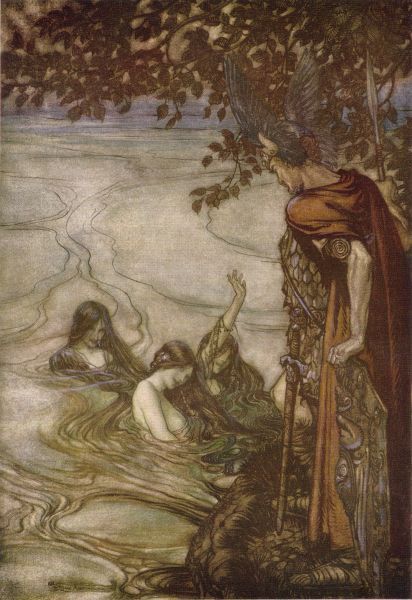
Undines, Spirits of Water
A term from Paracelsus derived from Latin unda, meaning "wave." Undines are elemental intelligences related to the fluidic, humid aspect of nature (water). In Tibetan, they are called lhu.
"Just as visible Nature is populated by an infinite number of living creatures, so, according to Paracelsus, the invisible, spiritual counterpart of visible Nature (composed of the tenuous principles of the visible elements) is inhabited by a host of peculiar beings, to whom he has given the name elementals, and which have later been termed the Nature spirits. Paracelsus divided these people of the elements into four distinct groups, which he called gnomes, undines, sylphs, and salamanders. He taught that they were really living entities, many resembling human beings in shape, and inhabiting worlds of their own, unknown to man because his undeveloped senses were incapable of functioning beyond the limitations of the grosser elements...
"As the gnomes were limited in their function to the elements of the earth, so the undines (a name given to the family of water elementals) function in the invisible, spiritual essence called humid (or liquid) ether. In its vibratory rate this is close to the element water, and so the undines are able to control, to a great degree, the course and function of this fluid in Nature. Beauty seems to be the keynote of the water spirits. Wherever we find them pictured in art or sculpture, they abound in symmetry and grace. Controlling the water element--which has always been a feminine symbol--it is natural that the water spirits should most often be symbolized as female.
"There are many groups of undines. Some inhabit waterfalls, where they can be seen in the spray; others are indigenous to swiftly moving rivers; some have their habitat in dripping, oozing fens or marshes; while other groups dwell in clear mountain lakes. According to the philosophers of antiquity, every fountain had its nymph; every ocean wave its oceanid. The water spirits were known under such names as oreades, nereides, limoniades, naiades, water sprites, sea maids, mermaids, and potamides. Often the water nymphs derived their names from the streams, lakes, or seas in which they dwelt.
"In describing them, the ancients agreed on certain salient features. In general, nearly all the undines closely resembled human beings in appearance and size, though the ones inhabiting small streams and fountains were of correspondingly lesser proportions. It was believed that these water spirits were occasionally capable of assuming the appearance of normal human beings and actually associating with men and women. There are many legends about these spirits and their adoption by the families of fishermen, but in nearly every case the undines heard the call of the waters and returned to the realm of Neptune, the King of the Sea.
"Practically nothing is known concerning the male undines. The water spirits did not establish homes in the same way that the gnomes did, but lived in coral caves under the ocean or among the reeds growing on the banks of rivers or the shores of lakes. Among the Celts there is a legend to the effect that Ireland was peopled, before the coming of its present inhabitants, by a strange race of semi-divine creatures; with the coming of the modem Celts they retired into the marshes and fens, where they remain even to this day. Diminutive undines lived under lily pads and in little houses of moss sprayed by waterfalls. The undines worked with the vital essences and liquids in plants, animals, and human beings, and were present in everything containing water. When seen, the undines generally resembled the goddesses of Greek statuary. They rose from the water draped in mist and could not exist very long apart from it.
"There are many families of undines, each with its peculiar limitations, it is impossible to consider them here in detail. Their ruler, Necksa, they love and honor, and serve untiringly. Their temperament is said to be vital, and to them has been given as their throne the western corner of creation. They are rather emotional beings, friendly to human life and fond of serving mankind. They are sometimes pictured riding on dolphins or other great fish and seem to have a special love of flowers and plants, which they serve almost as devotedly and intelligently as the gnomes. Ancient poets have said that the songs of the undines were heard in the West Wind and that their lives were consecrated to the beautifying of the material earth." —Manly P. Hall, Secret Teachings of All Ages
"The four elements of Nature—earth, fire, water, and air—are merely condensations of the four types of ether. These four varieties of ether are densely populated by innumerable elemental creatures of Nature. The salamanders live within the fire (the Tejas Tattva). The ondines and nereids live within the water (the Apas Tattva). The sylphs live within the clouds (the Vayu Tattva). The gnomes and pygmies live within the earth (the Prithvi Tattva)... The physical bodies of the ondines are the elementals of the plants that are influenced by the zodiacal signs of water." —Samael Aun Weor, Esoteric Medicine and Practical Magic